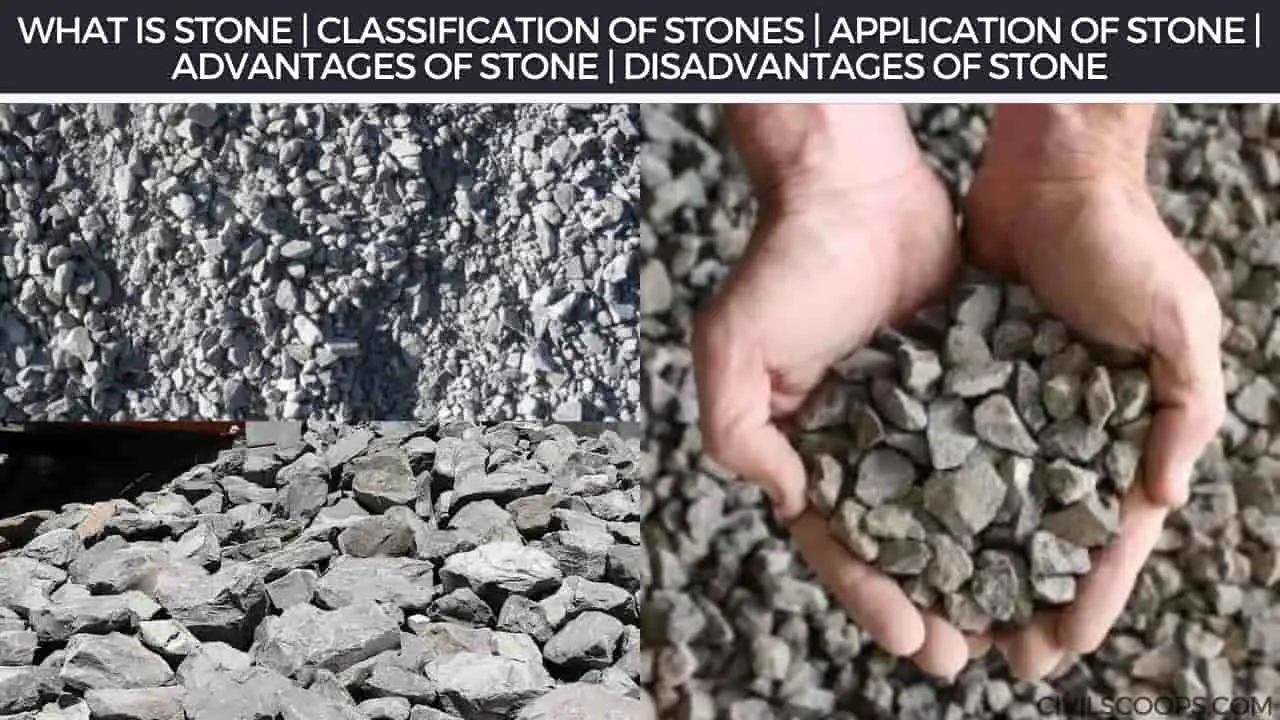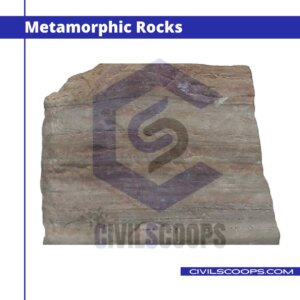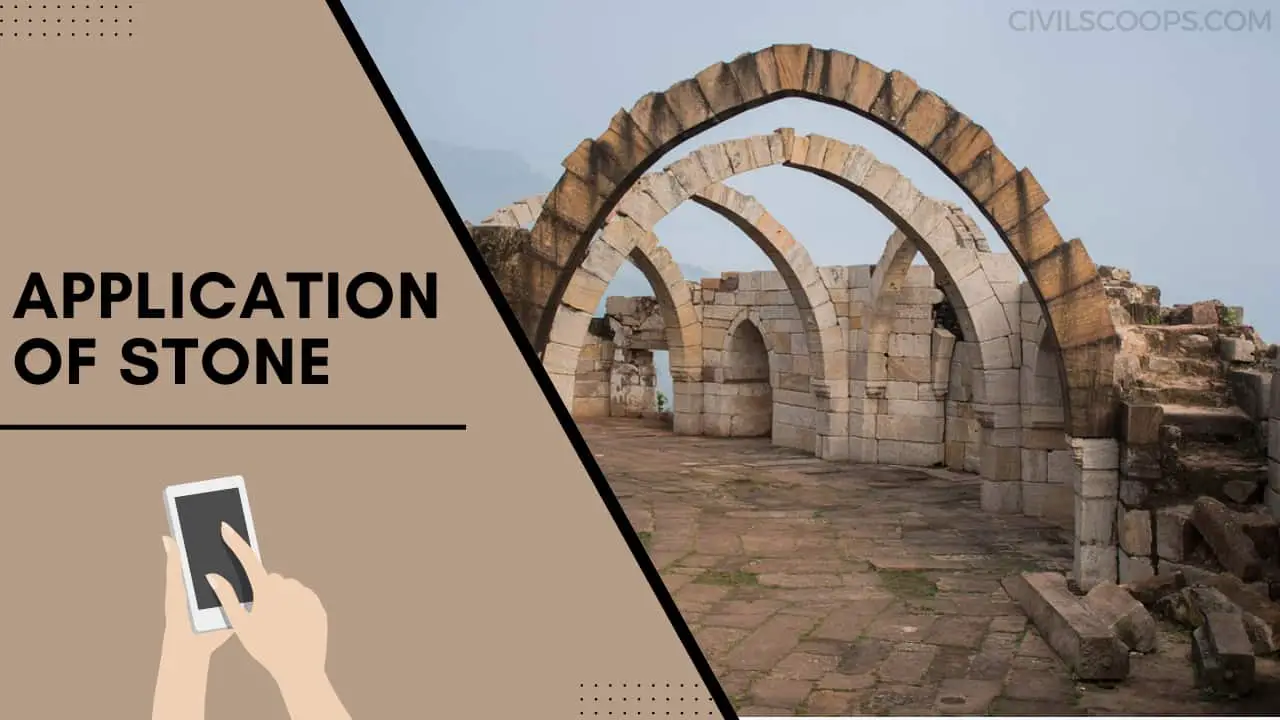What Is Stone | Classification of Stones | Application of Stone | Advantages of Stone | Disadvantages of Stone

Table of Contents
What Is Stone?
Stones were some of the essential construction materials in civil engineering. Stones are formed of rocks that comprise the crust of the earth and therefore have no regular shape or chemical composition and are mixes of 2 or even more minerals.
The mineral is a material produced by an inorganic materials mechanism which exhibits a distinct chemical composition, including molecular structure. They’re solid, robust, yet they look like a descent.
Classification of Stones

The characteristics of a stone which specify its functionality for building construction are durability, strength, hardness, and presentation. The consistency of a stone could be reliably and roughly determined by examining its source as well as chemical structure, as well as the outcomes of tests and experiments.
The rocks were categorized as
- As per geological origin, rocks are categorized as igneous, sedimentary, and metamorphic.
- As per physical type, rocks are categorized as stratified, unstratified, and foliated.
- As per chemical structure, rocks are categorized as siliceous, argillaceous, and calcerous.
1. Classification of Stones: As Per Geological
That’s the grouping of rocks mostly on the basis of its source as well as composition. In this principle, the rock is categorized as:
- Igneous Rocks.
- Sedimentary Rocks.
- Metamorphic Rocks.
1.1. Igneous Rocks

Igneous Which, rock developed when the substance is liquid or partly molten, termed magma, cools then solidifies. The internal surfaces of the planet are at such an elevated temperature, allowing the mass of silicate to melt. The melting mass of silicates is named magma, which has been pushed up then exposed to the earth’s surface.
Such an eruption is referred to as a volcanic eruption. This same magma emitted cools down and solidifies into a crystalline rock. Rocks produced inside the earth being considered intrusive or plutonic rocks since the magma through which these develop also intrudes further into the surrounding rock.
Such rocks produced on the earth’s surface are considered extrusive rocks. In extrusive rocks, the magma had also extruded or erupted, via a volcano or maybe a crack. Geology enthusiasts can distinguish amongst intrusive versus extrusive rocks from the size of its crystal.
Crystals in intrusive rocks are greater than crystals in extrusive rocks. The crystals within intrusive rocks become heavier, so the magma which creates these is protected either by underlying rock and hence steadily cools down. Such a slow cooling allows the crystals time to get bigger.
Extrusive rocks cool easily, since crystals are quite thin. For certain instances, molten magma cools so fast that perhaps the crystals can not have time to develop, as well as the magma solidifies in an amorphous shell, including such obsidian.
1.2. Sedimentary Rocks

Sedimentary rocks were produced mostly by accumulation of its minerals accumulated in each of the aforementioned three ways Mechanical degradation and eventual accumulation of many other stones, typically by water, like in the situation of sandstone and limestone; Its behavior of animals and plants, like in the situation of coral;
Chemical deposition of minerals through water, like in the situation of gypsum. Many sedimentary rocks being distinguished by parallel as well as discordant bedding, which indicates differences whether in the amount of deposition of the material or perhaps the composition of the material being settled. Sedimentary rocks are
categorized as per the source in mechanical and chemical sedimentary rocks.
Mechanical rocks, or fragmentary rocks, have been formed of mineral composite particles either by mechanical breakdown of many other rocks as well as transported, all without chemical decay, by flowing water. so they really are transferred to wider sources of water in which they are stored in deposits.
Shale, sandstone as well as conglomerates are typical sedimentary rocks of mechanical origins. Components that form chemical sedimentary rocks can comprise of residues of small marine species precipitated mostly on the ocean bottom, like in the situation of limestone.
These could also have been diluted with water flowing thru the parental rock formation and instead washed into the sea or lake by precipitation again from solution. Halite, gypsum as well as anhydrite are produced either by evaporation of dissolved salts as well as the resulting accumulation of salts.
Owing to the process of formation, sedimentary rocks are typically porous and therefore can be readily spread all along bedding. Such characteristics can differ based on the characteristics of the sediment as well as the bond form.
Also Read: What Is Clay Product | Types of Clay Product
1.3. Metamorphic Rocks

Metamorphic Rock is often a category of rock produced whenever the rock content encounters extreme pressure and temperature in the earth’s crust. Metamorphic rock occurs as pre-existing rocks experience mineral and structural variations due to high pressure and temperature. This modifications take place in the rock as it is firm.
Changes can happen when the rock remains firm since each mineral is durable just above a certain temperature and pressure range. When a mineral is heated or compressed outside its strength range, it starts to break down but becomes another mineral.
The mixture of minerals is effective across particular pressure and temperature scales. At temperatures and pressures above the specific range, the materials condense to produce various combinations of minerals. These combinations of minerals are termed mineral assemblages.
In such a metamorphic rock, one mineral assemblage switches to an other the atoms shift in a solid form then combining to create new minerals. This transition through one mineral assembly or the other is considered metamorphism.
When temperature and pressure rise, the rock increases power which stimulates the chemical reactions which also trigger metamorphism. When temperature and pressure drop, the stone cools; sometimes it doesn’t even have enough energy to return to reduce temperature and reduced pressure mineral assemblies.
In such a way, the rock is trapped in a situation which is typical of all its former high-temperature as well as high-pressure climate. The scale, shape, including arrangement of mineral grains in such a rock is termed the rock texture.
Most of the metamorphic rocks are known after their key texture. Textures offer important insights about how the rock was developed. If the pressure and temperature of that same metamorphic rock rise, the size of the mineral grains increases dramatically.
2. Classification of Stones: As per Physical Form
Rocks are often marked as stratified and non-stratified, based on its composition. Igneous and metamorphic rocks are unstratified, such that, these were not organized in almost any homogeneous way in layers and strata, and also have the component elements mixed up.
Sedimentary rocks become stratified or developed in a sequence of parallel layers once they are collected out of water. The surfaces were initially horizontal because in most situations they are somewhat inclined as well as curved caused by the actions of the troubling forces.
Sedimentary rocks consist of grains joined together with a cement medium, but its strength as well as longevity rely on the composition of the cementing content.
3. Classification of Stones: As per Chemical Composition
Rocks can also be graded as siliceous, calcareous as well as argillaceous, dependent on the chemical characteristics of the soil containing its key components. Silica is the primary constituent of the earth in silica stones; Lime carbonate seems to be the primary element in calcareous stones.
Use of Stone
The use of stone are as follows.
- As in the primary material for its foundation of structural engineering activities as well as for the building of walls, arches, buttresses including dams.
- Stonemasonry in areas where it would be readily accessible.
- As the total aggregate of concrete cement.
Also Read: 21 Different Types of Arches Construction
Application of Stone

The application of stone are as follows.
- Stones are being used for basic preparing of various constructions and very often serve as essential Stones are being used for basic construction work such as base, floor coverings, masonry work, respectively.
- Stones are being used for ornamental as well as decorative elegance of various styles of buildings.
- Normally, these are being used for rail ballast and also as aggregates for cement including lime concrete.
- Stones are being used in the production of iron.
- Stones are often used to create fireproof buildings.
- Normally, stones have been used as building materials for various buildings, such as dams, foundations, bridge piers, ports, etc.
- Limestone serves as a fluid in the processing of cement and lime.
- Stones can be used for the simple planning of various constructions but often regarded as an important product for road as well
as footpath construction. - A stone sheet will be used as a damp proof course (DPC) in components built up of many other structural units, including bricks,
hollow stones, respectively.
Advantages of Stone
The advantages of stone are as follows.
- Such rocks are present in nature in a broad variety of styles and colors and also have a distinctive elegance.
- Natural stones are thermal insulation and ,thus no modification is needed.
- Some other characteristics of natural stone are versatility as well as formability on a number of materials.
Disadvantages of Stone
The disadvantages of stone are as follows.
- The mass of the natural stone is greater than that of the artificial stone, but also being used in the construction is time consuming process.
- Weather and climate conditions influence the rock structure and trigger cracking, mildew as well as dandruff to the soil.
- Natural stones were stripped from of the structure of the building by atmospheric as well as non-stick agents across periods.
[su_box title=”FAQ” style=”default” box_color=”#333333″ title_color=”#FFFFFF” radius=”3″ class=”” id=””]
What Is Stone?
A rock is any naturally occurring solid mass or aggregate of minerals or mineraloid matter. It is categorized by the minerals included its chemical composition and the way in which it is formed. Rocks are usually grouped into three main groups: igneous rocks, sedimentary rocks, and metamorphic rocks
Use of Stone
Buildings, walls, paving slabs. Aggregates – stone used for its strong physical properties – crushed and sorted into various sizes for use in concrete, coated with bitumen to make asphalt or used ‘dry’ as bulk fill in construction. Mostly used in roads, concrete and building products.
Application of Stone
Stones are used for the ornamental and architectural beauty of different types of structures. Generally, they are used for railway ballast and as an aggregate in cement and lime concretes. Stones are used in the manufacturing of iron. Sometimes, Stones are used for making fireproof structures.
Advantages of Stone
Stone will not bend warp, splinter, dent, or swell. It is also very difficult to leave a scratch or chip in stone. The elements and outdoor weather, such as rain, snow, sleet, and even hail, will not have any effect on stone. Additionally, because stone is so strong and durable, it will last for a very long time.
Disadvantages of Stone
Stone walls are thick and heavy, reducing floor space. It also has a high self-weight, combined with low flexural strength, tensile strength and seismic resistance. Stone masonry is time-consuming and it requires skilled workers, since it cannot be altered, repaired or relocate easily.
Classification of Stones
Scientists put a stone into one of three main categories. Those categories are igneous, sedimentary, and metamorphic. Each type of rock is assigned a class by examination of its characteristics.
Properties of Stone
Stone is a heterogeneous substance characterized by wide ranges of mineral com- position, texture, and structure. Consequently, the physical and chemical pro- parties, i.e., the durability, are extremely variable.
Use of Stone in Architecture
Because of its attractiveness, strength, and durability, stone is used in many forms on architectural projects. Natural dimension or block stone and crushed stone are used on interior and exterior building components of walls, foundations, stairs, chimneys, and for paving projects.
Sources of Stones
Quarries are located all around the world. A majority of natural stone comes from Italy, Spain, Turkey, United States, Mexico, China, Taiwan, India, Greece, Canada, France, and Brazil. The minerals in stone came from the same liquid and gas minerals that formed the earth.
[/su_box]
[su_note note_color=”#F2F2F2 ” text_color=”#333333″ radius=”3″ class=”” id=””]
Like this post? Share it with your friends!
Suggested Read –
- What Is Clay Product | Types of Clay Product
- What Is Plaster | Plaster Ratio | History of Plastering | Requirements of Good Plaster
- What Is Drip Irrigation | Drip Irrigation Advantages | Types of Irrigation | Drip Irrigation System
- Tests on Stones | Crushing Strength Test, Water Absorption Test, Abrasion Test, Impact Test, Acid Test
- What Is Self Compact Concrete | What Is Slump Flow Test | Equipment for Slump Flow Test | Procedure of Slump Flow Test
[/su_note]
Originally posted 2022-07-19 14:41:04.
